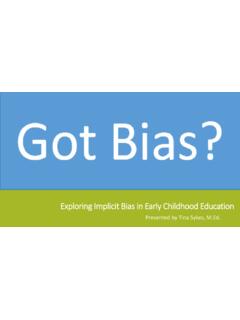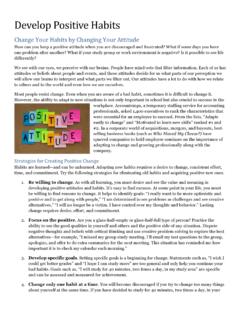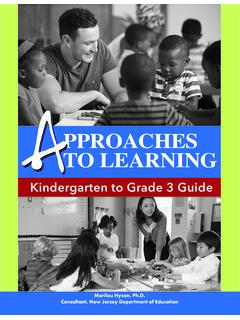Transcription of Table of Contents - Horry County Schools
1 Table of Contents Character Education Overview .. 1. SECTION 1: School-Based Character Education .. 2. Overview .. 2. Curriculum and Instruction .. 3. School-wide Integration .. 3. Service Learning .. 3. Section 2: School-wide Professional Development .. 4. Cross-Curricular Activities .. 4. Awareness: The Key to Friendships .. 4. Teen Trendsetters .. 4. Integrating Character Education into Different Subjects .. 5. English Language and Literature .. 5. Number Skills and Science .. 5. History and Geography .. 5. Lesson Plans .. 6. Teaching Responsibility Across Curricula .. 6. Teaching Trustworthiness through Service-Learning Projects .. 8. Integrating Knowledge & Wisdom .. 9. Integrating Health Care & Technology into English Language Arts .. 9. Other Helpful Websites for Integrated Character Education Programs or Lesson Plans .. 13. Harvesting Rewards of Character Education .. 13. Section 3: School/Community Partnership.
2 15. Parent Resources .. 15. Community Partners .. 16. Cities and Communities of Character .. 16. Community-Based Programs .. 17. Grants .. 17. SECTION 4: Research Findings .. 19. Character Development Research .. 19. Character Education Rubric .. 21. SECTION 5: South Carolina Promising Practices .. 22. 2009 Promising Practice Awards Winners .. 22. State School of Character Award / National School of Character Award .. 24. Teen LEAD .. 24. Red 25. Heart Award (Higher Education Awareness Readiness Transition) .. 25. State Board of Education Volunteer Awards .. 26. SECTION 6: Teacher Resources .. 27. Publishers and Catalogs .. 27. Professional Literature .. 29. SCDE Resource Room Books .. 29. Model Character Education Lesson 30. Additional Resources .. 44. Character-Based Programs .. 46. Related Websites .. 54. Electronic Newsletters .. 60. Quotes .. 60. Children's Literature by Character Trait.
3 60. Character Song List .. 67. SECTION 7: Calendar of Events .. 69. 71. APPENDICES. Richland One Character Education Guide Grades K-2 .. 72. Richland One Character Education Guide Grades 3-5 .. 179. Richland One Character Education Guide Grades 6-8 .. 295. Richland One Character Education Guide Grades 9-12 .. 404. Richland One Character Education Evaluation .. 463. Berkeley's Health Standards for Character Education .. 466. Character Education Overview Definition of Character 1. Character is the sum of continuously developing moral and ethical qualities and the demonstration of those qualities in people's emotional responses, thinking, reasoning, and behavior . 2. Character may be represented by values and virtues: a. Personal values people's ideals expressed by their behavior in a wide range of situations and activities ( , honesty, courage, perseverance, self-discipline, responsibility, integrity).
4 B. Social values people's behavior and attitudes toward others, especially in relation to family, peers, teachers, and others in their immediate social environment ( , caring, respect, empathy, trustworthiness, fairness, tolerance of diversity). c. Civic virtues people's behavior and attitudes toward the community, society, and government ( , engaged citizenship, patriotism, justice, welfare). 3. Character conveys: a. Moral knowledge and reasoning people's behavior that is based in moral ideals, such as considering others' perspectives, treating others as one wishes to be treated, acting as one wishes anyone would act in the same situation, and honoring the intrinsic worth of each person b. Moral emotions people's behavior that demonstrates empathy and sympathy for others and situation-appropriate feelings of guilt and remorse toward the self Character Education 1. Character Education encompasses the multiple layers of influences that families, Schools , and other social institutions have on positive character development of children and adults.
5 As such, it focuses on: a. Recognizing and understanding the strengths of families, neighborhoods, and communities b. Creating positive social climates and cultures in social institutions, especially Schools c. Empowering teachers to recognize that teaching character is teaching the whole child 2. Character Education creates a meaningful framework and incorporates aspects of social- emotional learning, conflict resolution, violence prevention, social skills training, and service learning Contact Information Joan Dickinson, Program of Character Education, 1429 Senate St., Columbia, SC 29201, Phone: (803) 734-4807, Fax: (803) 734-8343. 1. SECTION 1: School-Based Character Education Overview 1. School-based Character Education is deliberate, planned, and proactive. 2. It emphasizes instilling, teaching, and promoting character qualities virtues, values, and principles. 3. It promotes the usefulness of character qualities across many contexts and places rather than focusing on skills useful only to specific situations ( , conflict resolution, reducing disciplinary problems).
6 4. It teaches virtues, values, and principles: a. Directly ( , knowledge of moral ideas, of examples and heroes). b. Indirectly ( , role modeling, literary examples). c. As important in themselves d. As supporting and promoting academic achievement in reading, math, science, and other subjects e. In engagement in wider school activities and events 5. Character Education professional development for teachers, administrators, and staff: a. Promotes positive school and student outcomes b. Enhances adult skills and character qualities 6. In addition, community and parent involvement deepens and broadens support for Character Education. In school, Character Education must be approached comprehensively to include the emotional, intellectual, and moral qualities of a person or group. It must offer multiple opportunities for students to learn about, discuss, and enact positive social behaviors.
7 Student leadership and involvement are essential for character education to become a part of a student's actions and beliefs. For successful implementation, Schools are encouraged to: Take a leadership role in bringing faculty, staff, students, parents, and community leaders together to identify and define elements of character they want emphasized Provide training on how to integrate character education into school and life 2. Form a partnership where students receive a consistent message about character traits for success in school and life Provide and encourage opportunities for adults to model exemplary character traits and positive/appropriate social behaviors Academic Environment Involves students in learning experiences that challenge them to meet real world standards Develops critical thinking through in-depth, balanced investigation of controversial issues Develops perseverance through a high challenge rite of passage Uses pedagogy that requires all students to achieve a specified level of mastery Uses a teaching methodology and grading system that helps students understand and strive for quality work Develops school-wide support systems that hold all students accountable for learning Creates a motto, honor code.
8 And traditions that build a unified culture of high expectations for learning and behavior Curriculum and Instruction Has a relevant, rigorous, and engaging curriculum Uses published curricular materials that develop critical thinking about value-laden current events Teaches media literacy Engages staff in aligning practices with performance character and moral character School-wide Integration Uses rubrics to help students self-assess, set performance goals, and monitor their progress Uses co-curricular activities to develop students' individual talents and the collective pursuit of excellence Builds a unified school culture around excellence and ethics by promoting high expectations for learning and behavior Creates a motto that expresses the school's commitment to excellence and ethics Develops an honor code Develops school traditions that express and strengthen the commitment to excellence and ethics Makes a character compact with parents Service Learning Integrates meaningful community service with instruction and reflection Involves cooperative rather than competitive experiences Promotes skills associated with teamwork and community involvement and citizenship Offers powerful opportunities to acquire the habits of critical thinking Is personally meaningful to participants and generates emotional consequences.
9 To challenge values as well as ideas, and hence to support social, emotional, and cognitive learning and development 3. Section 2: School-wide Professional Development School-wide professional development promotes positive school and student outcomes, and it enhances adult skills and character qualities. Professional development focuses on school-wide systemic change. It prepares educators and school leaders to create safe, healthy, high-performing Schools , while inspiring students to reach their full potential as students and as people. Cross-Curricular Activities Awareness: The Key to Friendships The program, Awareness: The Key to Friendships offers school districts the opportunity to help students without disabilities, as well as teachers and people in their community, better understand what it is like to live with a disability. Teen Trendsetters Teen Trendsetters Reading Mentors is a free, award-winning program that recruits and trains high school students to mentor elementary students in reading.
10 This one-on-one mentoring does more than help elementary students improve their reading skills it also forges a rewarding relationship for the mentee and a lasting sense of achievement and responsibility for their teen mentors. Select teens are thoroughly prepared for mentoring and are trained to work with BrainStorm , a specialized 40-minute curriculum published by Scholastic. BrainStorm includes three topic areas, each with a 10-session, skill-based student magazine, a comprehensive tutor guide, and books that become part of the elementary student's home library. Teen mentors meet with their mentee students once a week for a minimum of 20 weeks during the school year. 4. Sedgefield Intermediate School in Goose Creek, South Carolina, benefits from this program. Students from Goose Creek High School mentor students at the intermediate school each week. The first year of the program was highly successful, and the second year promises to be so as well.






